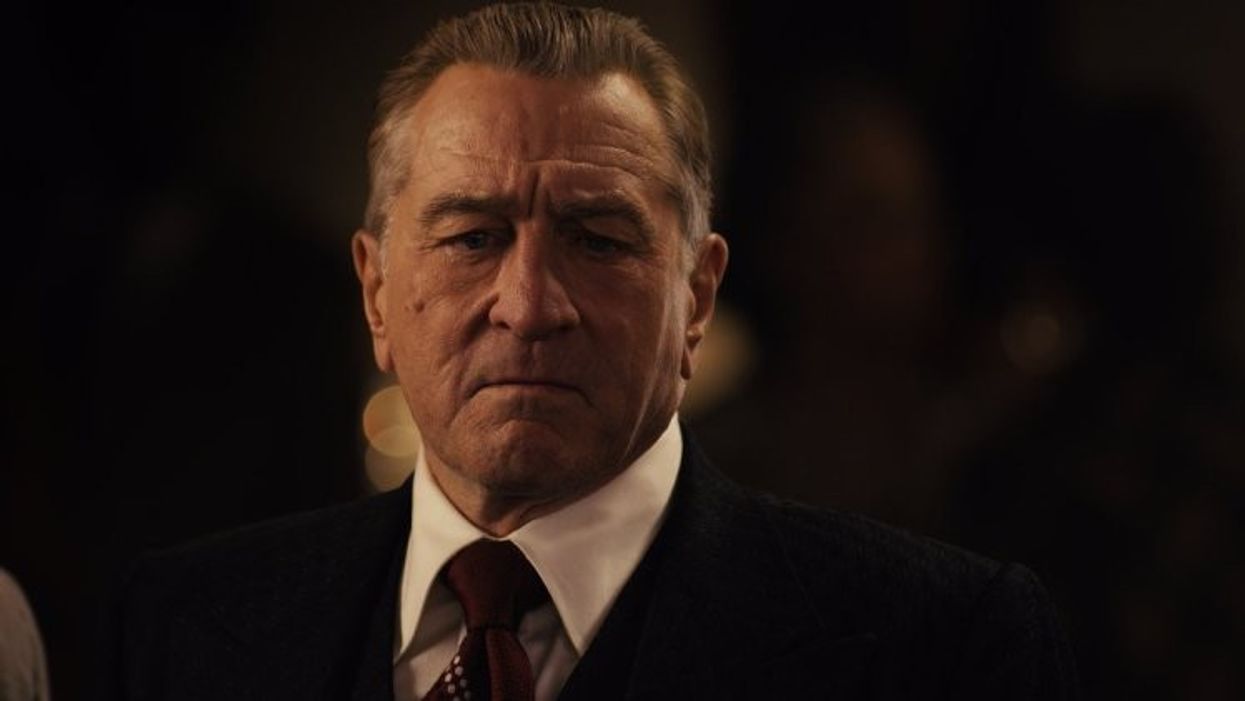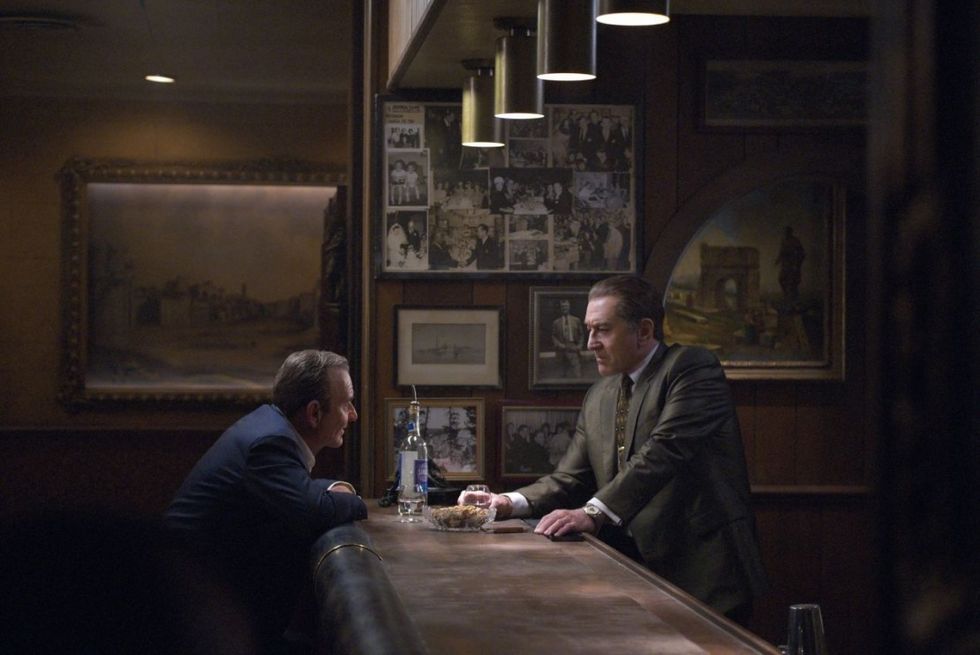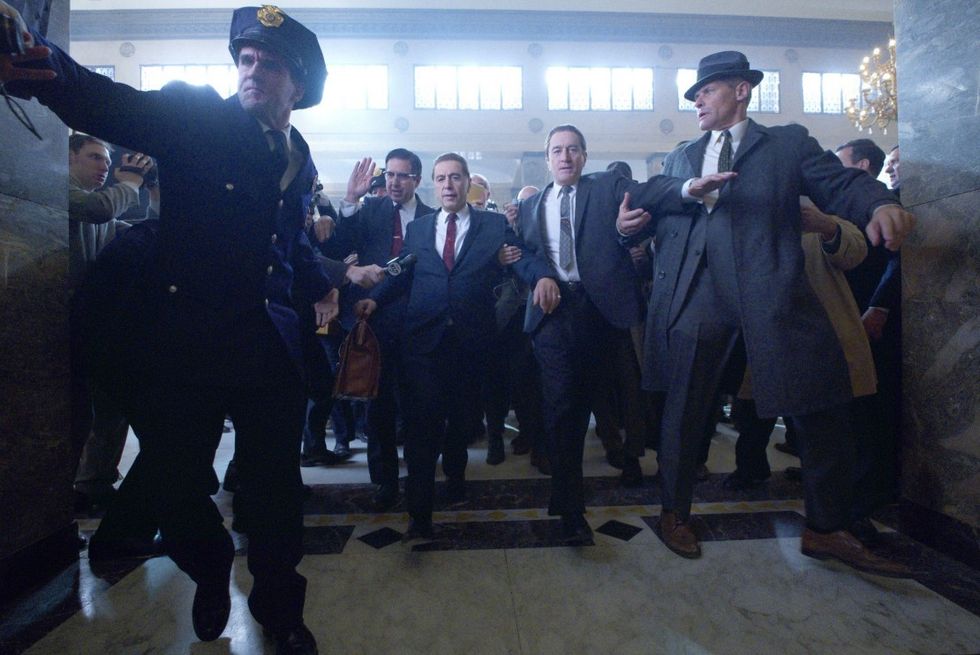Scorsese Reveals How 'The Irishman' Finally Got Made
At the world premiere of Martin Scorsese's 3.5-hour Netflix epic, the director sat down with Al Pacino, Joe Pesci, Robert De Niro, and the film's producers to discuss its decades-long journey to the screen.

The opening sequence of Martin Scorsese's The Irishman is a meandering tracking shot through the drab corridors of a nursing home. Eventually, the camera settles upon an old man. He's alone, and the gravity of his solitude hangs thick in the air.
His name is Frank Sheeran.
This is the (mostly true-life) story of his rise and fall from grace: From a truck driver of humble origins to successful mafioso, and finally to isolated elderly man weighed down by monumental regrets. That we meet him at the end is fitting -- the movie will unfold like a novel, with lengthy passages and heart-stopping moments that are earned by spending ample time with the characters. The film's three-and-a-half-hour runtime makes it a perfect fit for Netflix, where it will be available to stream on November 27, following a limited theatrical release November 1.
"We couldn't get the backing — there was no way — for years," Scorsese said.
The Irishman reunites some of the best talents in Hollywood for its epic journey into the machinations of the mafia and elegiac meditation on growing old. De Niro shares the screen with Al Pacino, who plays the passionate and hot-headed labor union president Jimmy Hoffa. Another Scorsese mob-movie icon, Joe Pesci, returns to the screen for only the third time in 20 years to play Russell Bufalino, the local head of the widely feared Philadelphia crime family, to whom Sheeran reports. The friendships between these men are the essential fabric of mafia life, though the mob is largely indifferent to them. This incongruence forms the emotional center of the film. As Sheeran comes to know, in the mafia, goodwill goes a long way, and pride is as delicate and destructive a force as death.
Scorsese, De Niro, Pacino, Pesci, and two of the film's producers -- Jane Rosenthal and Emma Tillinger Koskoff -- all took to the stage following the world premiere of The Irishman at the 2019 New York Film Festival. They discussed the film's decade-long journey to the screen, the de-aging technology ILM developed for the film, the grueling nature of the production, and more.
Netflix Saves the Day
In 2007, Rosenthal recalled, a conversation between then-Paramount head Brad Grey and Scorsese's team paved the way for screenwriter Steven Zaillian to adapt Charles Brandt's book I Heard You Paint Houses into The Irishman.
"[Brad Grey] said what every producer wants to hear," said Rosenthal. "'You mean to tell me that this movie you want me to green-light is now a development deal?'"
Scorsese wanted to use de-aging technology to enable the largely septuagenarian actors to play 40-year-old versions of their characters. ILM agreed to develop. But the endeavor proved too costly, and Paramount abandoned the project. For nearly a decade, The Irishman was relegated to development hell.
"We couldn't get the backing — there was no way — for years," Scorsese said. "Ultimately, that was [Netflix CEO] Ted Sarandos." The movie was financed with a budget of $160 million.

An Epic Production
"The wait time between the [original Paramount deal and the Netflix production] was actually a positive thing for the picture, because the technology kept evolving," Rosenthal said.
Indeed, the catalyst for the Sarandos' decision to finance the project was seeing a demo of the de-aging technology that ILM had been perfecting over the years. Scorsese prepared a scene from Goodfellas, in which he de-aged De Niro's performance using the technology. When De Niro himself saw the demo, the actor said, “I thought, ‘I can extend my career another 30 years.'”
Scorsese had been intent on developing the technology because he didn't want makeup or traditional mo-cap gear to interfere with the often subtle performances that this film would require from the actors. "[Industrial Light & Magic] had come up with the solution for the de-aging process that wouldn't interfere with Bob and Al talking to each other with helmets on their faces," Scorsese said, referring to the on-set process that would have been necessary to make the three lead actors look young again using practical means.
"It's a costly experiment," Scorsese added. "Ted and everyone at Netflix said they'd go with it. They backed the film, financed it, and were creatively attuned to us. There was no interference. There were some notes from time to time, but we addressed them."
As for the film's method of distribution, Scorsese suggested that he envisioned the streaming experience that the Netflix audience would have while directing the film.
"It was an interesting hybrid, in a way," the Oscar-winner said. "How you balance between what a film is and what is viewed at home and in a theater or in festivals? We're in an extraordinary time of change. When it comes down to it, though, we felt the picture had to be made for ourselves, really."
Scorsese explained that the ILM technology required two cameras that each had three lenses — which cinematographer Rodrigo Prieto dubbed "the three-eyed monsters." Scorsese initially worried about the maneuverability of these cameras, but they were ultimately able to fit in the sets' tight corners. Often, one scene would require two "three-eyed monsters," bringing the lens total per scene to six.
Incredibly, Tillinger Koskoff revealed that the unique VFX and cinematography needs didn't much impact the production. "The technology didn't slow us down," she said.
All told, the production had nine cameras, 309 scenes, 117 locations, and 108 shooting days. That meant "more trucks than a usual production," Scorsese said. The crew sometimes moved locations as many as three times a day.
"People always talk about how it's so great on sets," Scorsese said. "No, it's work! But we enjoyed doing the work."
And judging by the early praise from critics, that work has paid off.
The Irishman opens in select theaters Nov. 1












